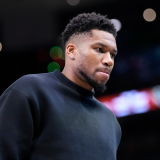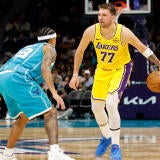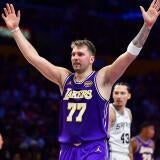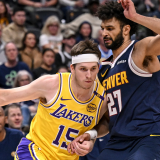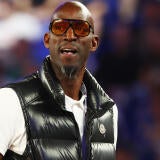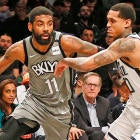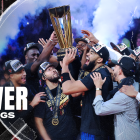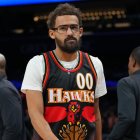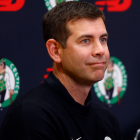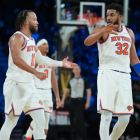That's Pretty Interesting: Kyrie Irving is back, and the Nets must decide how much playmaking they need
With Irving, Spencer Dinwiddie and Caris LeVert, Brooklyn is just one example of a team trying to find balance
NEW YORK -- Atlanta Hawks coach Lloyd Pierce expressed sympathy for Brooklyn Nets coach Kenny Atkinson on Sunday. "I feel for Kenny," Pierce said, as the Nets have three high-level playmakers to keep happy. Kyrie Irving was returning from a shoulder injury that sidelined him for almost two months, and his presence would mean fewer touches for Spencer Dinwiddie and Caris LeVert.
"[Atkinson] is going to have to try and balance a lot of that as they move forward," Pierce said.
The sentiment might not have been entirely sincere. His Hawks have the East's worst record and the league's worst point differential. Without Trae Young on the court, they have scored a horrific 90.7 points per 100 possessions. Young sat out at Barclays Center with a hamstring injury, so they started Brandon Goodwin, a two-way player who has spent most of the season in the G League, in his place. Atlanta have used an extra creator or two.
Pierce said Dinwiddie has "proven he's an All-Star, in my opinion." He called LeVert and emerging young player and described Joe Harris, the sharpshooter Pierce coached on Gregg Popovich's Team USA staff last summer, "an unbelievable player" and "a great competitor." He labeled Atkinson's challenge a good problem to have.
"They've got a lot of fire over here," Pierce said. "There's some other guy that will get back next year that's all right, too. I think sometimes you just forget how good this team can be when you add it all up."
Irving torched the Hawks for 21 points in 20 minutes. He missed only one of his 11 shots. It took the Nets less than 11 minutes to take a 20-point lead, en route to a 108-86 win. Dinwiddie and LeVert weren't particularly efficient, but given how little of the game was competitive, their stat lines didn't feel particularly significant.
The relevant numbers are these: In 174 minutes on the court with Irving, Dinwiddie's usage rate has been 20.9 percent, down from 32.3 percent in 1,032 minutes without him. LeVert, who missed almost three months after thumb surgery, has a 21.2 percent usage rate alongside Irving and a 32.8 percent usage rate with the star point guard on the bench. The three of them have only played together for 38 minutes spread over eight games, and Irving's 34.1 percent usage rate in those minutes indicates that Dinwiddie and LeVert have deferred to him.
The Nets' backcourt situation raises a broader team-building question: How much playmaking do you need?
Last season, I argued that 3-and-D was no longer enough: Coaches want everyone to be able to dribble, pass and shoot. If you have numerous players who can put the ball on the floor, it makes you less vulnerable against switches, less predictable and more injury-proof.
This season, though, has seen a rise of what The Athletic's Seth Partnow calls heliocentrism, with offenses increasingly revolving around extremely ball-dominant stars. Three of the nine highest single-season usage rates in NBA history belong to Luka Doncic, James Harden and Giannis Antetokounmpo in 2019-20. Their teams rank first, second and third in offensive rating. If you're lucky enough to have a player of that caliber, you can get a lot out of simply giving him space and letting him work.
There are benefits to having a clear hierarchy, and there can be real problems when too many players are thirsty for touches. Last season, Terry Rozier famously called the Boston Celtics "too talented" and LeBron James hilariously pooh-poohed the Los Angeles Lakers' ill-fated strategy of surrounding him with playmakers instead of shooters. Now both teams are much more balanced and almost completely devoid of public drama.
The Celtics, though, remain hardly heliocentric. They start a relatively high-usage point guard and three skilled wings, all of whom can drop 30-plus points if they're feeling it. Critics of the Lakers tend to say that they will need another perimeter threat in the playoffs, especially when James, who colorfully complained about the "top-heavy as s---" Cleveland Cavaliers roster three years ago, is on the bench.
If the Nets need an example to follow, they could do worse than the Oklahoma City Thunder, who are destroying teams with Chris Paul, Shai Gilgeous-Alexander and Dennis Schroder on the floor. Last week in Brooklyn, Thunder coach Billy Donovan said that the three-point-guard look "doesn't work if those guys are not willing to sacrifice," and they all understand that "we can't just have one of them be the primary guy and the other two guys are just standing around." The idea is to move the ball, use their speed, attack weak defenders and make each other better. In theory, Brooklyn could play similarly with Irving, Dinwiddie and LeVert on the court.
"I think that's a lineup that excites our coaching staff," Atkinson said. "I think we'll get there. At the end of the day, I think what good coaching staffs do is they put their best players on the floor. They try to manage those, get those lineups together as much as they can. Those are our top players and we have to figure out a way."
Ideally, coaches do not have to choose between playmaking and shooting. If someone as gifted as Stephen Curry is willing to play off the ball, set screens and accommodate another megastar, surely players without MVP trophies can figure it out. Most players, however, are not equally dangerous with and without the ball. Irving is an awesome shooter, but he lives to break down defenses and at 27, he is not about to lower his usage rate the way Paul has. Dinwiddie is shooting 37.5 percent on catch-and-shoot 3s in his four seasons with the Nets, a fine number, but Atkinson isn't going to start using him like Joe Harris. LeVert's career mark on catch-and-shoot 3s is 33.6 percent.
Atkinson said there is no "strict answer" as to when playing a bunch of creators together is overkill. "You can't have six ballhandlers out there," he said. "Or four. It doesn't work." He acknowledged that it will take time for Brooklyn to sort out its rotation.
"You have to have balance on your roster between catch-and-shoot guys and guys that are downhill guys," Atkinson said. "We'll find that balance."
On the offensive end, this is what the rest of the Nets' season is about. It was always going to be a transitional year with Kevin Durant rehabilitating from Achilles surgery, but that doesn't mean it is a meaningless one. Now that Irving and LeVert are healthy, the front office can see how the guards mesh. If they find it difficult to find rhythm and complement each other now, imagine what it will be like next season.
On that subject, what about Utah?
Here's another quote on the Nets' situation, courtesy of Utah Jazz coach Quin Snyder: "Anytime you have a team that has multiple ballhandlers, they're matchup problems. Particularly when they're as good [as the Nets' guards]. I think as they play with each other and figure out kind of how to maximize one another at various times in the game, that's just the process. We've kind of gone through that as well at various times. I think you'll see that continue to evolve."
Snyder said that before the Jazz's 118-107 victory at Barclays Center on Tuesday, in which Joe Ingles matched his career high with 27 points on 10 for 14 shooting. Ingles began the season as a sixth man, and largely struggled to find his comfort zone until Mike Conley hurt his hamstring in early December and he rejoined the starting lineup. The Jazz have looked undeniably more Jazzy since then, and they have won 15 of 16 games, albeit against a weaker schedule.
Ingles has averaged 15.4 points on 69.5 percent true shooting since Conley was sidelined. Snyder, however, pushed back on the idea that this happened because of Conley's injury. I will quote him in full:
"That narrative I think is not entirely accurate. I think that Joe and Mike and Donovan (Mitchell) and Bojan (Bogdanovic), we've got a number of guys that are capable of making plays. And you know in a given game, in a given stretch of games, you're going to see those guys figure out on a given night with the matchup, who's got a hot hand. I think one of the biggest things for Joe is he's had the ball in his hands and making decisions in pick-and-roll. Also, he's not worrying about whether the ball goes in. He's just playing with a lot of freedom. He's just more definitive when he's shooting the ball. There's some things that he's doing just fundamentally on the court. He's been really disciplined about using fakes and using his footwork. And Joe's a really good player. Sometimes when you start a year at a level that you haven't been at, it's more noticeable. So we're happy the way Joe's playing. We'll be excited when we get Mike back. For our team it's difficult to kind of say, 'You go; you go; you go again; he hasn't touched it, now you go twice, you have a hot hand.' So I think a lot of it is those guys just getting to know each other and playing off each other over the course of a game."
Snyder is defending Conley here, but he is also making many of the same points that have been made by everybody who has noted that Ingles has thrived without the guard. A few thoughts:
- It isn't Conley's fault, exactly, that Ingles wasn't himself early in the season. The presence of Conley and Bogdanovic, though, created the conditions that led to him playing differently. Typically, "playing with freedom" and being "definitive" when shooting go hand-in-hand with playmaking responsibility. It is not a coincidence that Ingles has had the ball in his hands and run more pick-and-rolls in the last six weeks.
- Mitchell has had a similarly striking surge. When Conley comes back, Snyder's coaching staff has to decide who will be coming off the bench and what the rotation will look like, but it's more than that: How can the Jazz help Mitchell grow into superstardom? How can they make Conley as efficient as he was in Memphis? How can they make sure the offense keeps humming this way?
- Utah's recent success is an argument for simplicity and familiarity. Ingles, Mitchell and Rudy Gobert know how to play together, and they do beautiful stuff with a floor spacer like Bogdanovic at power forward. There was good rationale, though, for signing Conley. Mitchell has not been all that efficient in the playoffs, and Conley has the pick-and-roll skills and shooting ability to take pressure off him. I don't know exactly how they should split the ballhandling duties, but I still think the best version of the Jazz will feature Conley, Mitchell and Ingles sharing the court in crunch time.
Yet another DeRozan check-in
Two days before Christmas, San Antonio Spurs wing DeMar DeRozan scored 26 points on 10-for-11 shooting and 10 assists in Memphis. LaMarcus Aldridge had 40 in the 145-115 blowout, and the big man shot an uncharacteristic 3-for-5 from downtown. And then he kept shooting them. On Dec. 28, Aldridge went 5-for-6 against the Pistons. On New Year's Day, he shot 4-for-4. In the Spurs' last 10 games, he has been as stretchy as Gumby, taking five 3s a game and making 56 percent of them.
This has fundamentally changed DeRozan's basketball life. With Aldridge drawing defenders to the perimeter, he finally has the space he needs. In that same stretch, DeRozan is averaging 27.3 points and 5.8 assists while shooting 63.4 percent. DeRozan leads the league in drives, per NBA.com's tracking data, and recently he's been just about unstoppable on them. This has led to recent victories over the Bucks, Celtics and Raptors, and an early contender for dunk of the year:
DeRozan is known as a midrange assassin (and he is shooting a career-high 47 percent on midrange shots this season, per Cleaning The Glass), but his most valuable skill is attacking the basket. He is outrageously good at drawing fouls, he can finish through contact and his footwork is just as valuable around the rim as it is when he's getting to his spots for jumpers. The last time I wrote about DeRozan in this space, I likened him to Ben Simmons with midrange shooting in place of elite defensive versatility (and good passing instead of great passing). This is what happens when he is used like Antetokounmpo:
Before that Grizzlies game, lineups featuring DeRozan and Aldridge had an offensive rating of 105.4, almost identical to the Cavaliers' 25th-ranked offense, and the Spurs were outscored by 8.5 points per 100 possessions with them on the court. From that game onward, those lineups have had an offensive rating of 124.1 (!) and have outscored opponents by 13 points per 100 possessions.
It looks like San Antonio has found something here, even though its defense remains rough and that kind of dominance likely isn't sustainable. The Spurs' 17-21 record looks blah, but they're only half a game out of the playoffs, and all of this could complicate their approach to the trade deadline. DeRozan has more trade value when he plays like this, and the same is likely true of Aldridge. But the case for keeping them around is stronger, too.
Keep an eye on Ayton
The No. 1 pick in the 2018 draft is coming off the bench behind Aron Baynes. I don't necessarily disagree with this choice, but it's worth monitoring how Deandre Ayton handles it. Phoenix Suns owner Robert Sarver, general manager James Jones and coach Monty Williams have all spoken to him about his role and their expectations for him, via the Arizona Republic's Duane Rankin, and Williams has publicly compared his development to that of Anthony Davis on several occasions.
One of the many differences between Davis and Ayton, though, is that as a rookie Davis helped his team in a variety of ways and didn't need the ball in his hands to do so. Even when he never posted up, didn't shoot 3s and averaged just 13.5 points, you could see his instincts, his ridiculous potential and the foundation of the all-around superstar he is today.
Davis was an elite pick-and-roll finisher before he was a threatening player in isolation. Ayton hasn't gotten the first part down and wants touches. He told the Arizona Republic that Suns coaches have been urging him to roll harder, and Williams said that Ayton needs to improve his conditioning so he doesn't fade at the end of games. Little things add up.
Before being selected No. 1, there was skepticism about whether Ayton could anchor a defense and make his teammates better. His upside is still obvious, but those questions linger.
Wooooooootten
Some genuinely fun New York Knicks news: They've signed one of the most explosive leapers in basketball. Kenny Wooten, who has spent the season with the Knicks' G League affiliate in Westchester, is now on a two-way contract. Look at this dude jump:
Good gravy.


